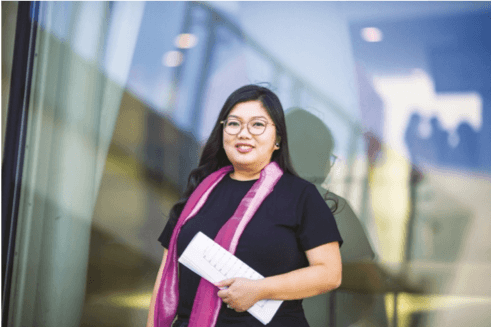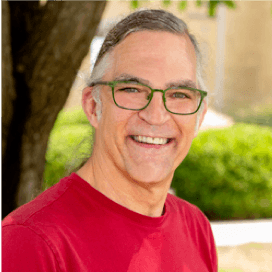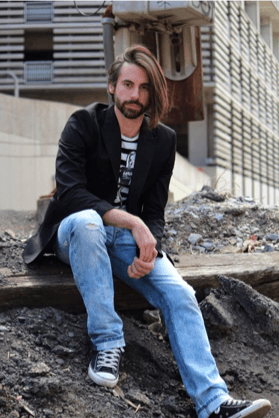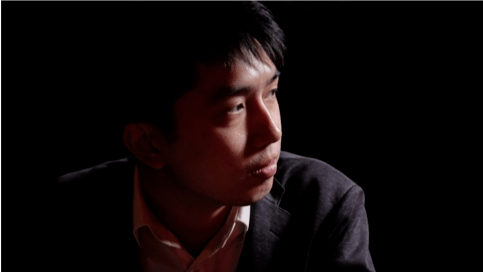
John Eagle is a composer, instrument builder, and performer. Drawing on various physical and digital technologies in extended instrumental systems, his work explores harmonic relationality as environmental processes.
Eagle has performed and presented work internationally including the Sound/Image Festival in London, Int-Act Festival in Bangkok, EMPAC’s Reembodied Sound, Heidi Duckler Dance’s Ebb & Flow festival, UC Irvine’s The Art of Performance, Hear Now Music Festival, Thailand New Music and Arts Symposium, Göteborg Art Sounds, Co-Incidence Festival, Live Arts Exchange, and the Dog Star Orchestra festival.
Recent collaborations include Sound House, a performance installation developed with Janie Gesier and Cassia Streb (which features a sixteen-channel wireless sound instrument he designed with Eric Heep) and his work with Charles Gaines as musical director and co-arranger for Manifestos 4, conducting the studio recording and premiere in Times Square in July 2022. He has created several collaborative instrument systems in workshops and performances with artists including Emily Call, Ford Fourqurean, and Piyawat Louilarprassert.
His music has been performed by Tacet(i) Ensemble, Brightwork New Music, Wet Ink Ensemble, Yarn/Wire, Isaura String Quartet, Southland Ensemble, Red Desert Ensemble, Unheard-of//Ensemble, Inverted Space, and others. Recordings of his music have been released by Sawyer Editions and Music For Your Inbox.

Described as “the future of composing” (The Straits Times, Singapore), Emily Koh is the recipient of awards such as the Copland House Residency Award, Young Artist Award (National Arts Council, Singapore), Yoshiro Irino Memorial Prize (Asian Composers League), ASCAP Morton Gould Young Composer Award, Prix D’Ete (Peabody), and the Macagnoni Prize for Innovative Research (University of Georgia). Her work is supported with commissions, grants and fellowships from the National Endowment of the Arts, National Arts Council (Singapore), Opera America, New Music USA, MacDowell, the Barlow Endowment for Music Composition, American Composers’ Orchestra, Women’s Philharmonic Advocacy, the Paul Abisheganaden Grant for Artistic Excellence (National University of Singapore) and others. Described as “beautifully eerie” (New York Times), and “subtley spicy” (Baltimore Sun), Emily’s music has been performed around the world, and is published by Babel Scores (Europe) and Poco Piu Publishing (worldwide). Emily is currently Associate Professor of Music Composition at the University of Georgia, USA.

Eric P. Mandat Clarinetist/Composer Clarinetist and composer Eric Mandat is internationally recognized for his groundbreaking contributions to contemporary clarinet music. He has premiered and performed his works at international festivals in Chicago, Stockholm, Tokyo, Vancouver, Porto, Los Angeles, and Madrid, and he has appeared as soloist with the Latvian National Chamber Orchestra, the Chicago Chamber Orchestra, and the Cleveland Chamber Symphony. Mandat is a member of the Chicago Symphony's MusicNOW ensemble, and he is also a member of Tone Road Ramblers, an eclectic sextet specializing in improvisation and experimental music. As a composer, Mandat focuses on solo and chamber works for clarinet. His compositions utilize extended techniques within a framework largely influenced by jazz and traditional music of non-Western cultures. He is a recipient of multiple Illinois Arts Council Artist Fellowship Awards for composition, and his music is featured in concerts and recordings by clarinetists throughout the world. A dedicated and in-demand teacher, Mandat has presented master classes and lectures at more than 100 conservatories and universities around the world, and he regularly appears as guest artist at clarinet-specific events throughout the United States. He also co-authors a performance analysis article series for The Clarinet with friend and colleague Boja Kragulj. Mandat received his education at the University of North Texas, the Yale School of Music, and the Eastman School of Music. He is Professor of Music and Distinguished Scholar at Southern Illinois University at Carbondale, where he was the recipient of the 1999 SIUC Outstanding Scholar Award. At SIUC, Mandat teaches clarinet and graduate courses in musical analysis. Eric Mandat is a Buffet Group USA performing artist and clinician.
Joey Miller is a manipulator of wiggly air as well as a tenor viola da gambist in the Bowling Green State University Early Music Ensemble. His music focuses primarily on human interactions and experiences. In 2022, his composition Hatcher Pass was a finalist for the American Composers Orchestra EarShot recording session. Also in 2022, his work Alone at 7:03, and the Stillness of the Lake was selected for BGSU’s Toledo Symphony Orchestra reading session. He is especially interested in implementing technology into his works. Final Lap, an interactive installation incorporates MarioKart Wii and SuperCollider to create both a unique playing experience, and is able to introduce non-musicians to electroacoustic music. He continues to play cello in various ensembles at BGSU. BGSU MM Tubist Max Godfrey commissioned and will be presenting a recital of works featuring tuba at the ITEA Midwest Regional Tuba Euphonium Conference in May 2024. Miller has studied music composition with Drs. Christopher Dietz, Mikel Kuehn, and currently Piyawat Louilarpprasert. His favorite musical is Hadestown and he loves to bake.

Originally from Bordeaux, Jean-Patrick Besingrand (b. 1985) is a French composer and musicologist based in Washington DC and New York. From his formative years as a keyboardist and guitarist in rock and heavy metal bands, Jean-Patrick has kept a particular interest for noise and distortion. In his music, he seeks to combine these timbral interests with an extended conception of silence and other absences in order to create contrasting and evolving sonic landscapes. As a composer he received several awards and recognition in France and abroad. His music has been performed around the globe by ensembles such as the Orchestre National Bordeaux- Aquitaine, Court-Circuit, Dal Niente, Linéa, Les Percussions de Strasbourg, Klangforum Wien, Mivos Quartet, JACK Quartet, Platypus, Barcelona Modern Ensemble, Moscow Contemporary Music Ensemble, Meitar Ensemble, Suono Giallo, Mise-En; and by many soloists, notably Pierre Dutrieu, Yumi Suehiro, Aurélienne Brauner, Geoffrey Deibel, Carla Rees, Mamiko Someda, Thomas Piercy, and Remi Miura.
Jean-Patrick holds a PhD in composition from The Graduate Center, CUNY, a Master of Arts in Musicology from the University of Bordeaux, and diplomas in Analysis, Harmony, Counterpoint, Fugue, Composition, and Soundpainting from the Bordeaux Conservatory. He also holds an Advanced Certificate in Composition from Carnegie Mellon University. Since 2018, he has served as co-artistic director and co-founder of the composers' collective Tesselat. His music is published by Artchipel and on BabelScores. More on https://jeanpatrickbesingrand.com/

Thanakarn Schofield is a Thai composer whose works explore the fusion of sonic ritual and drama. His works have been performed and featured in new music festivals more than 15 countries, such as: British Council "UK-Southeast Asia Connections Through Culture" (UK/Thailand), CIEL 2nd Series (France), China-ASEAN Music Festival (China), Dias de Music Electroacustica (Portugal), Dutch Harp Festival (Netherlands), Gaudeamus Residentie Launching (Netherlands), OutHear New Music Week (Greece), IntAct Festival (Thailand), Simpósio Internacional de Música Nova (Brazil), Sounding Tomorrow (Hong Kong SAR), ReMusik - St. Petersburg Contemporary Music Festival (Russia), Thailand International Composition Festival (Thailand), 26th Young Composers Meeting (Netherlands), and among others. His compositions have also been performed by renowned ensembles: Hezarfen Ensemble (Türkiye), Hong Kong New Music Ensemble (Hong Kong), Klangforum Wien (Austria), Kluster 5 (Netherlands), Linea Ensemble (France), Mivos Quartet (USA), Moscow Contemporary Music Ensemble (Russia), Orkest de Ereprijs (Netherlands), Tacet(i) Ensemble (Thailand), TAK Ensemble (USA), and others. He was awarded the Princess Maha Chakri Sirindhorn Prize – grand prize of the Young Thai Artist Award 2017, Orkest de Ereprijs – “St. Frank van der Wal Fonds” prize 2020 (Netherlands), Yokohama International Composition Call for Score 2016 (Japan), Hong Kong New Music Ensemble Call for Score 2021 (Hong Kong SAR), and Princess Galyani Vadhana Youth Orchestra Call for Score 2021 – Orchestra Composition Competition (Thailand). He holds a B.M. from the Royal Academy of Music in London (United Kingdoms), an M.M. from Koninklijk Conservatorium Den Haag (Netherlands), and is currently a doctoral student at the Graduate Center, CUNY (USA). In 2022, Thanakarn was awarded the Graduate Center Teaching Fellowship, through which he is currently teaching world music at the City College of New York.
diamond rotations (2020) presents a situation for musicians to discover harmonic shapes being realized in physical space. These shapes arise from a conception of harmonic space where prime ratios (2/1—octaves, 3/2—fifths, 5/4—major thirds, 7/4—natural sevenths) each define independent axes. Pitches, in such a space, are represented as points, whose neighbors along each axis move up or down according to the intervals just listed. Every set of pitches in this piece forms the shape of a diamond when viewed as a plane using one of the pairs of harmonic axes (i.e. 2/1 could be the X-axis, so to speak, and 3/2 could be the Y-axis). The diamond is a closed shape meaning that there are no end points and each point is connected with exactly two neighboring points.
The six performer stations are positioned in the same kind of diamond shape and each computer plays a synthesized tone corresponding to one of the points in the harmonic shape. Every set of adjacent points from the harmonic shape produces combination tones which are presented to each performer as a set of available pitches from which to choose (combination tones are achieved by adding/subtracting two tones and, though here are used as a compositional element, are a real psychoacoustic phenomenon that can add harmonic depth to harmonic dyads). Many of these tones, though natural, are microtonal according to equal temperament. The performers are asked to search for the intonation (tune) in each of these intervals while physically searching for the point playing the other pitch which produces their combination tone. In harmonic space, this point is one of the two neighbors, but in the performance space the pitches have been randomly scrambled among the six stations so the performers must rely solely on their ears in finding the second point. Once all the performers have reached their new stations, a new pitch set is triggered and the process begins again. Sometimes, this new pitch set is a rotation along one point of the prior diamond shape, meaning that one of the axes remains the same and one changes while at least one of the pitches will remain constant. While each shape is predefined, the rotations are variable with the performers occupying different points in each iteration. As the cycle unfolds and repeats the harmonic clarity will constantly fluctuate leaving the shape to reveal itself, perhaps, only momentarily.
ombré adjective \ˈäm-ˌbrā\ definition: having colors of tones that shade into each other – used especially in fabrics in which the color is graduated from light to dark origin: From French, past participle of ombrer (to shade.) From Italian, ombrare, from ombra (shade.) From Latin, umbra, from umbrage (shade/shadow.) First known use: 1893
Double Life was written in honor of Clarinet asked/composer William O. Smith, who has been a major influence on my work as a Clarinet as a composer for more than 30 years. Bill’s innovation and his mastery of extended performance techniques have been a constant source of inspiration for me. I was thrilled to be asked by Deborah Bish to be a part of a tribute concert for Bill at the International Clarinet Association’s ClarinetFest of 2007 in Vancouver, and I chose to honor him by composing this work. The title refers to the “Two Sides of William O. (Bill) Smith,” a classic album which featured Bill’s legit compositions and his jazz music. The first movement, “Double life,” juxtaposes short jazz licks with slow, free two- or three-note cells, then combines them as the performer plays both motives simultaneously on B-flat and A clarinet. The second movement, “Deep Thoughts,” utilizes an extension built of PVC tubing. The third movement expressed what we clarinetists hope for the future of Bill’s innovations: “To Be Continued…” II. Deep Thoughts: “The holes in the PVC holes are to be covered by the inside of the left or right leg when indicated in the score; sitting to perform this movement is desirable. The 16th-note notation above long tones indicates a rhythmic undulation between covering the indicated holes in the score and opening them to the normal fingering for the given note. Be aware of the shift to bass clef on page two.”
Visions of Reality is taken from the Tibetan Buddhist belief relating to the transition between death and rebirth– the Bardo of Dharmata. It is a time when the mind bears witness to the true nature of the world and forces which govern it. The piece translates this into music by using fragments of melody over a meditative backdrop.
Ce masque de chair d’emprunt is a quotation from William Burrough’s novel The Naked Lunch, and of which my memories of reading as a teenager are the point of departure for this piece. I recall a novel made like a collage with surrealist moments. I wanted to recreate this deconstructed form in this piece. Blocks of different materials are juxtaposed without any supposed relationship. A handful of these materials come from previous pieces and are reorchestrated, deconstructed, and reconstructed. The overall structure is based on an acceleration of events leading up to an anti-climactic meditative moment.
“Hear My Prayers" is a semi-ritualistic and political piece that features a sonic ritual generated by a combination of objects and instruments. It also includes synthesised voices of those who have suffered and fallen as political victims. Although, the performers do not aim to recreate the actual sense of the ritual or assume the roles of the victims, they will embody the personae of political all-stars. The text in the piece derived from statements by current and historical political figures such as Netanyahu, Hitler (from "Mein Kampf"), Farrakhan, and Biden. Several texts from the political declarations made by these "players" have been altered and encoded into "Pig Latin," revealing their nonsensical words and thereby referring their true aims, which extend well beyond mere proclamations, thus reducing subjugated civilians to pawns/sacrifices of their grand game.
Keri Lee Pierson, soprano
Claudia Daniela Aizaga Chavez, flute
Ricky Latham, clarinet
Jacob Paul Loitz, saxophone
Hayden Mesnick, piano
Sujin Kim, violin
Hayley Rose Currin, cello
Jacob Ryan Koch, percussion
Piyawat Louilarpprasert, conductor
Thanks for attending this performance. If you have enjoyed your experience, please consider donating to the College of Musical Arts in support of our students and programming. Donate online at bgsu.edu/givecma, or call Sara Zulch- Smith at 419-372-7309.
To our guests with disabilities, please indicate if you need special services, assistance or appropriate modifications to fully participate in our events by contacting Accessibility Services, access@bgsu.edu, 419-372-8495. Please notify us prior to the event.
Audience members are reminded to silence alarm watches, pagers and cellular phones before the performance. As a matter of courtesy and copyright law, no recording or unauthorized photographing is allowed. BGSU is a nonsmoking campus.
Updated: 04/04/2024 04:42PM
